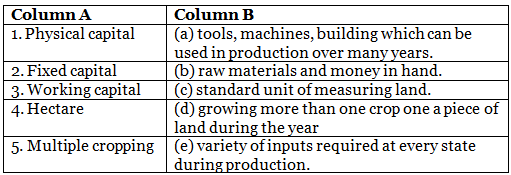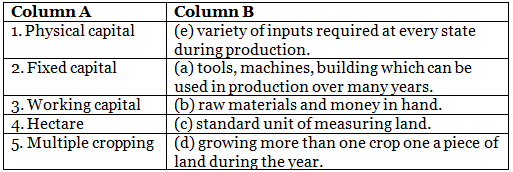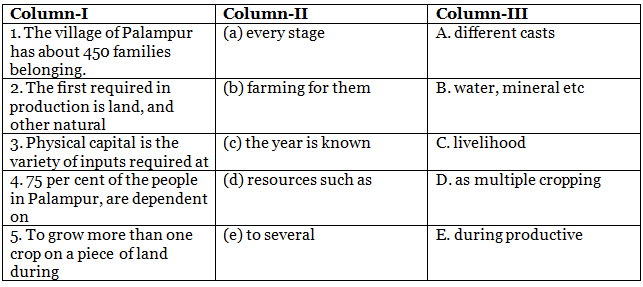Class 9 Economics Chapter 1 Practice Question Answers - Economics
Q1: Palampur resembles a village of the western part of the state of:
(a) Gujarat
(b) Rajasthan
(c) Maharashtra
(d) Uttar Pradesh
Ans: (d)
Palampur resembles the rural area of Uttar Pradesh.
Q2: During the rainy season, farmers in Palampur grow:
(a) wheat and barley
(b) wheat and rice
(c) wheat and bajra
(d) jowar and bajra
Ans: (d)
During the rainy season, farmers in Palampur grow jowar and bajra.
Q3: All farmers in Palampur grow atleast two main crops may are growing:
(a) sugarcane as the third crop
(b) rice as the third crop
(c) potatoes as the third crop
(d) onion as the third crop
Ans: (c)
Many farmers in Palampur grow potatoes as the third crop.
Q4: Yield is measured as crop produced on a given piece of land during:
(a) two seasons
(b) three seasons
(c) a single season
(d) all the above
Ans: (c)
Yield is measured as the crop produced on a given piece of land during a single season.
Q5: The Green Revoluti jn in the late 1960s introduced the Indian farmer to cultivation of:
(a) wheat and jowar
(b) jowar and barley
(c) wheat and sugarnae
(d) wheat and rice
Ans: (d)
The Green Revolution favoured the growth of wheat and rice.
Q6: People in Palampur feed t ieir buffaloes on various kinds of grass and the jowar and bajra that grows during the:
(a) summer season
(c) rainy season
(d) none of the above
Ans: (c)
Jowar and bajra are grown during the rainy season
Q7: The traders of Palampur are shopkeepers who buy various goods from:
(a) retailers and sell them in the village
(b) wholesale markets in the village and sell them in the cities
(c) wholesale markets in the cities and sell them in the villages
(d) none of the above
Ans: (c)
Traders buy from wholesale markets in the cities and sell them in the village.
Q8: What is the main activity in Palampur?
(a) manufacturing
(b) dairy
(c) farming
(d) none of the above
Ans: (c)
The main activity in Palampur is farming.
Q9: The village of Palampur has about families belonging to several different castes.
(a) 450
(b) 550
(c) 650
(d) 750
Ans: (a)
Palampur has approximately 450 families belonging to several different castes.
Q10: The majority of land in the village is owned by:
(a) lower caste families
(b) upper caste families
(c) landlords
(d) all the above
Ans: (b)
The majority of land in villages is owned by upper castes families.
Fill in the blanks
Q11: The village of Palampur has about __________ families belonging to several different castes.
Answer: 450
The village of Palampur, which is a hypothetical village created in the NCERT textbook to explain rural economy, is composed of around 450 families. These families belong to several different castes, highlighting the diverse social structure that exists within rural India.
Q12: The __________ upper caste families own the majority of land in village Palampur.
Answer: 80
The majority of land in village Palampur is owned by the 80 upper caste families. This reflects the socio-economic disparity and inequality in land distribution prevalent in rural India, where upper caste families often own a large portion of the land.
Q13: The Scheduled Castes (SCs) comprise __________ of the population and live in the corner of the village.
Answer: one-third
The Scheduled Castes (SCs) comprise one-third of the population in Palampur, and they live in the corner of the village. This statement depicts the spatial segregation based on caste system in rural areas, where marginalized groups are often pushed to the periphery of the village.
Q14: The houses of SCs are much smaller and made up of mud and __________.
Answer: straw
The houses of the SCs in Palampur are much smaller and made up of mud and straw. This is indicative of their socio-economic status and the lack of access to resources, leading to poor housing conditions.
Q15: Electricity powers all the __________ in the fields and is used in various types of small businesses.
Answer: tubewells
In the village of Palampur, electricity powers all the tubewells in the fields and is also used in various types of small businesses. This signifies the increasing reliance on modern technology and the role of electricity in enhancing agricultural productivity and facilitating rural entrepreneurship.
True/False
Q16: The story of Palampur is an imaginary village.
Ans: True
This statement is correct as per the NCERT economics textbook for Class 9. The village of Palampur is a hypothetical or imaginary village that has been used as an example to explain different concepts of the economy, including production, factors of production, farming, etc.
Q17: The aim of production is to produce goods only.
Ans: False
The aim of production is not just to produce goods, but also services. The production process includes the creation of both tangible goods like clothes, food, etc., and intangible services like teaching, healthcare, etc.
Q18: The first requirement for products is land and other natural resources such as water, forests, minerals, etc.
Ans: True
This statement is correct. Land and other natural resources like water, forests, minerals, etc., are indeed the primary requirements for production. These resources are part of the four factors of production, which also include labor, capital, and entrepreneurship.
Q19: Some production activities require highly educated workers to perform the necessary tasks.
Ans: True
Certain production activities do require skilled and highly educated workers. For instance, jobs in the technology sector, healthcare, engineering, etc., require specialized knowledge and education.
Q20: Fixed capital refers to a variety of inputs required at every stage during production.
Ans: False
This statement is incorrect. Fixed capital refers to the non-consumable part of the capital which is not used up in the production process. It includes assets like buildings, machines, tools, etc., that are used over a long period and do not change their form during the production process.
Matching Questions
Q21:

Ans:
Q22:
Ans:
FAQs on Class 9 Economics Chapter 1 Practice Question Answers - Economics
| 1. What is the main economic activity in Village Palampur? |  |
| 2. How does the irrigation system work in Palampur? |  |
| 3. What role does the transport system play in the economy of Palampur? |  |
| 4. How has the introduction of modern farming methods impacted agriculture in Palampur? |  |
| 5. What are the challenges faced by farmers in Palampur? |  |





















